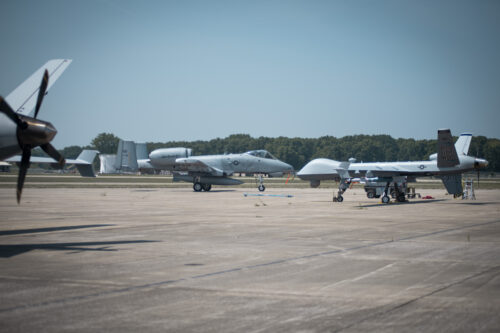In a groundbreaking display of military efficiency, aircraft maintainers showcased their mastery of Agile Combat Employment (ACE) during a recent operation, performing Integrated Combat Turns (ICT) that involved transferring inert munitions from an A-10 Thunderbolt II to rearm an MQ-9 Reaper. This seamless process took place while the engines of both aircraft were running on the ground, allowing for rapid redeployment and readiness for combat.

The operation, aptly named Operation Bruiser, unfolded at the Battle Creek Air National Guard Base, where the usually vacant airfield became a hub of activity. A team of skilled maintainers from the 110th Wing and the Air National Guard meticulously planned and executed the event as part of the larger Northern Strike 23-2 exercise. The focus of Northern Agility was on developing and honing ACE tactics to complicate adversary decision-making processes.
At the center of the operation were two aircraft – the MQ-9 Reaper and the A-10 Thunderbolt II. Despite being unmanned, this MQ-9, affectionately known as “Battle,” was remotely piloted by U.S. Air Force Lt. Col. Jeffrey Campbell and sensor operator Senior Master Sgt. Robert Myers, who operated it from Fargo, North Dakota. The MQ-9 was customized with a unique tail flash designed explicitly to support the ACE mission during Northern Agility.
As the two aircraft taxied onto the airfield, aircraft maintainers sprung into action. In an unprecedented move, munitions from the A-10 were safely transferred to the MQ-9, effectively rearming the drone for combat operations. All the while, the engines of both aircraft were continuously running, a first in the history of MQ-9 Reaper operations.
The process, known as Integrated Combat Turn (ICT), is a vital component of Agile Combat Employment. ICT enables aircraft to be rapidly rearmed, inspected, and refueled while still hot and ready to take off for their next mission. This remarkable feat requires precise coordination, efficient communication, and well-trained personnel, all of which were demonstrated flawlessly by the aircraft maintainers.
Master Sgt. Steven Jones, a sensor operator from the 172nd Attack Squadron, expressed his pride in the accomplishment. He stated, “Today’s event showcased the interoperability between the A-10 and MQ-9, demonstrating an integrated combat turn, while both aircraft had engines running. This is just a sample of what the men and women at the 110th Wing and the Air National Guard can accomplish.”
The successful implementation of ACE and ICT is not just a matter of efficiency; it also has significant implications for future warfare strategies. The ability to rapidly redeploy aircraft with minimal turnaround time enhances the military’s agility and flexibility in responding to rapidly changing situations and emerging threats.
For more information, hit the Source below